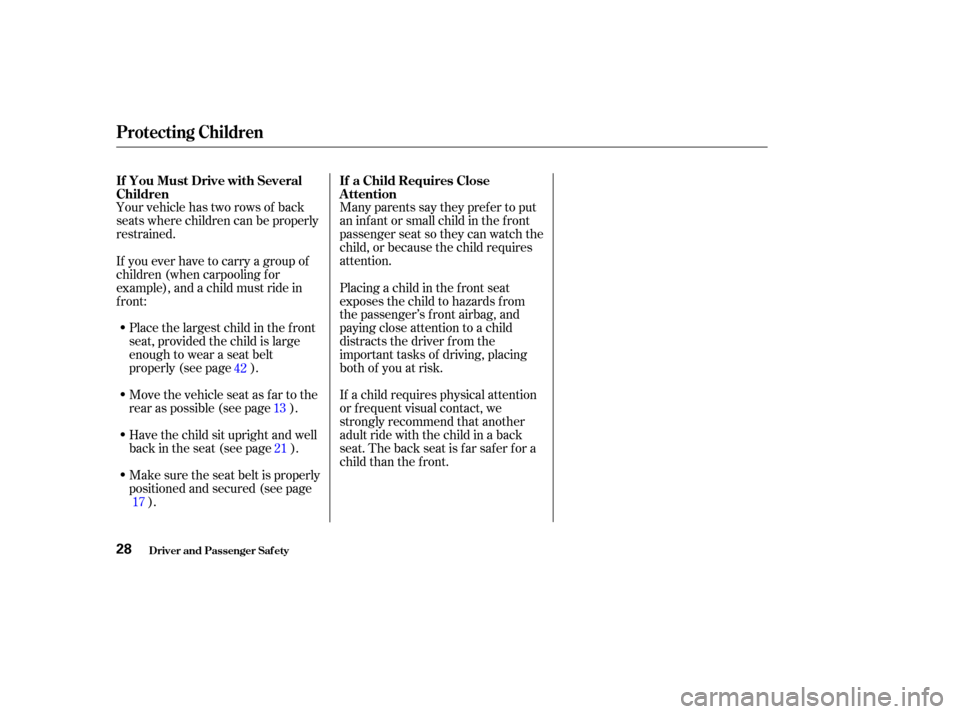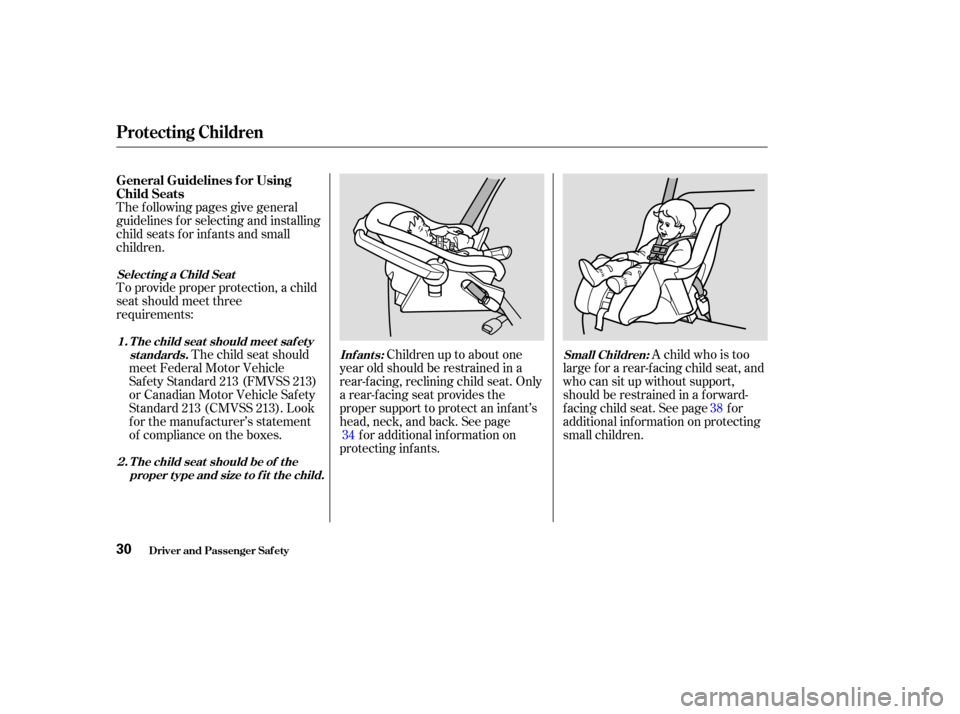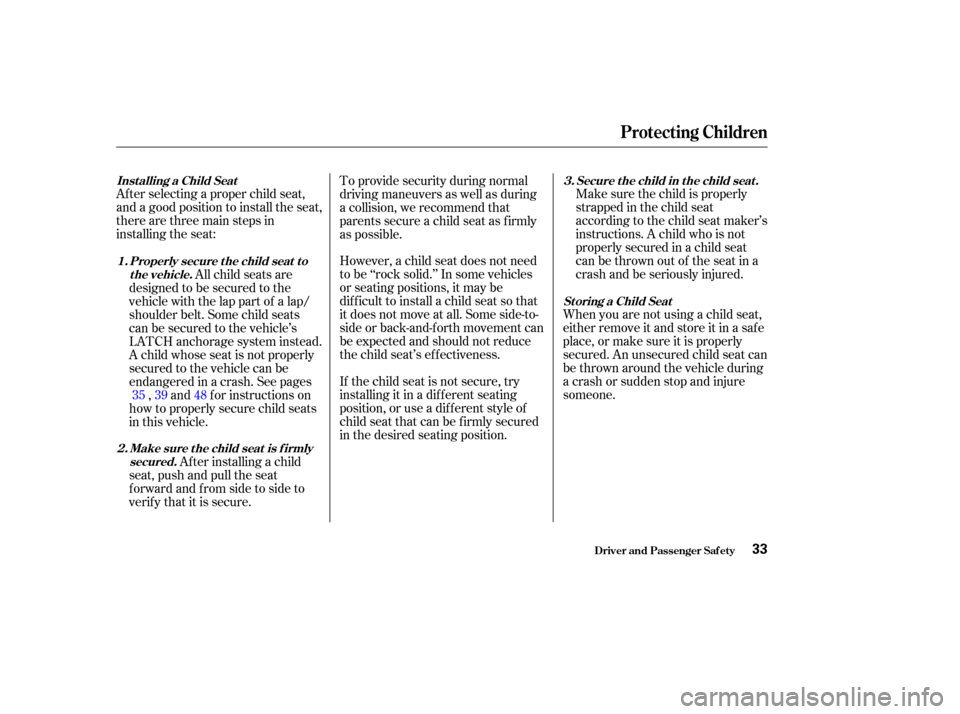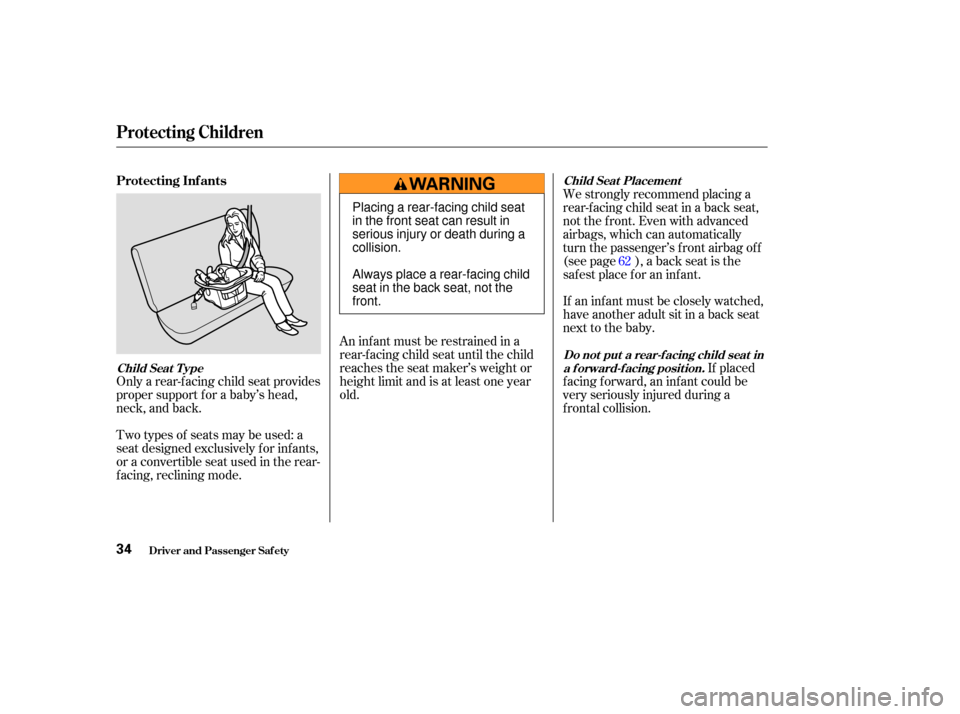Page 29 of 415
Front airbags have been designed to
help protect adults in a moderate to
severe f rontal collision. To do this,
the passenger’s f ront airbag is quite
large, and it can inflate with enough
f orce to cause very serious injuries.With an advanced airbag system, the
f ront passenger’s airbag is turned of f
if sensors detect a total weight of
less than about 65 lbs (30 kg) in the
seat, and the ‘‘Passenger Airbag
Cutof f ’’ indicator is turned on. (See
page f or additional inf ormation on
how the passenger’s airbag works.)
Even if the passenger’s f ront airbag
is turned of f , we strongly
recommend that inf ants, small
children, and larger children ride
properly restrained in a back seat
wheretheywillbesafer.
To help prevent airbag-caused
deaths and injuries to children, this
vehicle has an advanced airbag
system. 57
Protecting Children
Driver and Passenger Saf ety
The Passenger’s Front Airbag
Can Pose Serious Risks
26
Page 30 of 415
To remind you of the passenger’s
f ront airbag hazards, and that
children must be properly restrained
in a back seat, your vehicle has
warninglabelsonthedashboardand
on the driver’s and f ront passenger’s
visors. Please read and f ollow the
instructions on these labels.To remind you of the f ront airbag
hazards, your vehicle has warning
labels on the driver’s and f ront
passenger’s visors. Please read and
f ollow the instructions on these
labels.
U.S. Models
Canadian Models
Protecting Children
Driver and Passenger Saf ety27
Page 31 of 415

Many parents say they pref er to put
an inf ant or small child in the f ront
passenger seat so they can watch the
child, or because the child requires
attention.
Your vehicle has two rows of back
seats where children can be properly
restrained.
Place the largest child in the f ront
seat, provided the child is large
enough to wear a seat belt
properly (see page ).
Move the vehicle seat as far to the
rear as possible (see page ).
Have the child sit upright and well
backintheseat(seepage ).
Make sure the seat belt is properly
positioned and secured (see page ).
If you ever have to carry a group of
children (when carpooling f or
example), and a child must ride in
front:
Placing a child in the f ront seat
exposes the child to hazards f rom
the passenger’s f ront airbag, and
paying close attention to a child
distracts the driver f rom the
important tasks of driving, placing
both of you at risk.
If a child requires physical attention
or f requent visual contact, we
strongly recommend that another
adult ride with the child in a back
seat. The back seat is far safer for a
child than the front.
42
1321
17 If a Child Requires Close
Attention
If You Must Drive with Several
Children
Protecting Children
Driver and Passenger Saf ety28
Page 33 of 415

The f ollowing pages give general
guidelines f or selecting and installing
child seats f or inf ants and small
children.
To provide proper protection, a child
seat should meet three
requirements:Childrenuptoaboutone
year old should be restrained in a
rear-f acing, reclining child seat. Only
a rear-f acing seat provides the
proper support to protect an inf ant’s
head, neck, and back. See page for additional information on
protecting inf ants. A child who is too
large f or a rear-f acing child seat, and
who can sit up without support,
should be restrained in a f orward-
f acing child seat. See page f or
additional inf ormation on protecting
small children.
The child seat should
meet Federal Motor Vehicle
Saf ety Standard 213 (FMVSS 213)
or Canadian Motor Vehicle Saf ety
Standard 213 (CMVSS 213). Look
for the manufacturer’s statement
of compliance on the boxes. 38
34
Protecting Children
Driver and Passenger Saf ety
General Guidelines f or Using
Child Seats
Select ing a Child Seat
T he child seat should be of theproper t ype and size t o f it t he child. Inf ant s:
Small Children:
T he child seat should meet saf et y
st andards.
1.
2.
30
Page 34 of 415
CONT INUED
Due to variations in the design of
child seats, vehicle seats, and seat
belts, all child seats will not f it all
vehicle seating positions.
However, Honda is conf ident that
one or more child seat models can f it
andbeproperlyinstalledinall
recommended seating positions in
your vehicle.Bef ore purchasing a child seat, we
recommend that parents test the
child seat in the specif ic vehicle
seating position (or positions) where
they intend to use the seat. If a
previously purchased child seat does
not f it, you may need to buy a
different one that will fit.
Your vehicle has lower anchors
installed f or use with LATCH
(Lower Anchors and Tethers f or
Children) - compatible child seats.
For more inf ormation, see page .
48
Protecting Children
Driver and Passenger Saf ety
T he child seat should f it the
vehicle seat ing posit ion (orposit ions) where it will be used.
3.
31
Page 35 of 415

This page brief ly summarizes
Honda’s recommendations on where
to place rear-facing and forward-
f acing child seats in your vehicle.Recommended positions.
Properlysecurearear-facingchild
seat (see page ).
Recommended
positions. Properly secure a f ront-
f acing child seat (see page ).
To help prevent airbag-caused
deaths and injuries to children,
this vehicle has an advanced
airbag system.
With this system, the front
passenger’s airbag is turned of f
if sensors detect a total weight
of less than about 65 lbs (30 kg)
in the seat.
Even if the f ront passenger’s
airbag is turned of f , we strongly
recommend that inf ants and
small children ride properly
restrained in a back seat where
they will be saf er. Not recommended. If
a small child must ride in f ront,
move the vehicle seat to the rear-
most position and secure a f ront-
f acing child seat with the seat belt
(see page ). Never in the f ront seat, due
to the f ront airbag hazard. Not
recommended.
39
35 39
Placing a Child Seat Front Passenger’s Seat
Back Seat sInf ant s:
Small children:
Small children:
Inf ant s:
Protecting Children
Driver and Passenger Saf ety
Airbags Pose Serious
Risks to Children
32
Page 36 of 415

Af ter selecting a proper child seat,
and a good position to install the seat,
there are three main steps in
installing the seat:Make sure the child is properly
strappedinthechildseat
according to the child seat maker’s
instructions. A child who is not
properly secured in a child seat
canbethrownoutof theseatina
crash and be seriously injured.
However, a child seat does not need
to be ‘‘rock solid.’’ In some vehicles
or seating positions, it may be
dif f icult to install a child seat so that
it does not move at all. Some side-to-
side or back-and-f orth movement can
be expected and should not reduce
the child seat’s ef f ectiveness. When you are not using a child seat,
either remove it and store it in a saf e
place, or make sure it is properly
secured. An unsecured child seat can
be thrown around the vehicle during
a crash or sudden stop and injure
someone.
If the child seat is not secure, try
installing it in a dif f erent seating
position, or use a dif f erent style of
child seat that can be f irmly secured
in the desired seating position. To provide security during normal
driving maneuvers as well as during
a collision, we recommend that
parents secure a child seat as f irmly
as possible.
Af ter installing a child
seat, push and pull the seat
f orward and f rom side to side to
verif y that it is secure. All child seats are
designed to be secured to the
vehicle with the lap part of a lap/
shoulder belt. Some child seats
can be secured to the vehicle’s
LATCH anchorage system instead.
A child whose seat is not properly
secured to the vehicle can be
endangered in a crash. See pages , and f or instructions on
howtoproperlysecurechildseats
in this vehicle. 39 48
35
Inst alling a Child Seat Secure t he child in t he child seat .
Storing a Child Seat
Make sure t he child seat is f irmly secured.
Properly secure t he child seat t o
the vehicle.
1.
2. 3.
Protecting Children
Driver and Passenger Saf ety33
Page 37 of 415

Only a rear-f acing child seat provides
proper support f or a baby’s head,
neck, and back.
Two types of seats may be used: a
seat designed exclusively f or inf ants,
or a convertible seat used in the rear-
f acing, reclining mode.An inf ant must be restrained in a
rear-f acing child seat until the child
reaches the seat maker’s weight or
height limit and is at least one year
old.We strongly recommend placing a
rear-facing child seat in a back seat,
not the front. Even with advanced
airbags, which can automatically
turn the passenger’s f ront airbag of f
(see page ), a back seat is the
saf est place f or an inf ant.
If an inf ant must be closely watched,
have another adult sit in a back seat
next to the baby.
If placed
f acing f orward, an inf ant could be
very seriously injured during a
f rontal collision. 62
Protecting Inf ants
Child Seat T ype Child Seat Placement
Do not put a rear-f acing child seat ina f orward-f acing position.
Protecting Children
Driver and Passenger Saf ety34
Placing a rear-facing child seat
in the front seat can result in
serious injury or death during a
collision.
Always place a rear-facing child
seat in the back seat, not the
front.